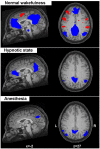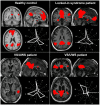Resting state networks and consciousness: alterations of multiple resting state network connectivity in physiological, pharmacological, and pathological consciousness States
- PMID: 22969735
- PMCID: PMC3427917
- DOI: 10.3389/fpsyg.2012.00295
Resting state networks and consciousness: alterations of multiple resting state network connectivity in physiological, pharmacological, and pathological consciousness States
Abstract
In order to better understand the functional contribution of resting state activity to conscious cognition, we aimed to review increases and decreases in functional magnetic resonance imaging (fMRI) functional connectivity under physiological (sleep), pharmacological (anesthesia), and pathological altered states of consciousness, such as brain death, coma, vegetative state/unresponsive wakefulness syndrome, and minimally conscious state. The reviewed resting state networks were the DMN, left and right executive control, salience, sensorimotor, auditory, and visual networks. We highlight some methodological issues concerning resting state analyses in severely injured brains mainly in terms of hypothesis-driven seed-based correlation analysis and data-driven independent components analysis approaches. Finally, we attempt to contextualize our discussion within theoretical frameworks of conscious processes. We think that this "lesion" approach allows us to better determine the necessary conditions under which normal conscious cognition takes place. At the clinical level, we acknowledge the technical merits of the resting state paradigm. Indeed, fast and easy acquisitions are preferable to activation paradigms in clinical populations. Finally, we emphasize the need to validate the diagnostic and prognostic value of fMRI resting state measurements in non-communicating brain damaged patients.
Keywords: anesthesia; coma; consciousness; default mode network; hypnosis; resting state networks; sleep.
Figures



Similar articles
-
Intrinsic functional connectivity differentiates minimally conscious from unresponsive patients.Brain. 2015 Sep;138(Pt 9):2619-31. doi: 10.1093/brain/awv169. Epub 2015 Jun 27. Brain. 2015. PMID: 26117367
-
Multiple fMRI system-level baseline connectivity is disrupted in patients with consciousness alterations.Cortex. 2014 Mar;52:35-46. doi: 10.1016/j.cortex.2013.11.005. Epub 2013 Nov 20. Cortex. 2014. PMID: 24480455
-
Neural correlates of consciousness in patients who have emerged from a minimally conscious state: a cross-sectional multimodal imaging study.Lancet Neurol. 2016 Jul;15(8):830-842. doi: 10.1016/S1474-4422(16)00111-3. Epub 2016 Apr 27. Lancet Neurol. 2016. PMID: 27131917
-
Resting state activity in patients with disorders of consciousness.Funct Neurol. 2011 Jan-Mar;26(1):37-43. Funct Neurol. 2011. PMID: 21693087 Free PMC article. Review.
-
Functional networks in prolonged disorders of consciousness.Front Neurosci. 2023 Feb 17;17:1113695. doi: 10.3389/fnins.2023.1113695. eCollection 2023. Front Neurosci. 2023. PMID: 36875660 Free PMC article. Review.
Cited by
-
A novel brain partition highlights the modular skeleton shared by structure and function.Sci Rep. 2015 Jun 3;5:10532. doi: 10.1038/srep10532. Sci Rep. 2015. PMID: 26037235 Free PMC article.
-
Optimal Organization of Functional Connectivity Networks for Segregation and Integration With Large-Scale Critical Dynamics in Human Brains.Front Comput Neurosci. 2021 Mar 31;15:641335. doi: 10.3389/fncom.2021.641335. eCollection 2021. Front Comput Neurosci. 2021. PMID: 33867963 Free PMC article.
-
The Combination of Functional and Structural MRI Is a Potential Screening Tool in Alzheimer's Disease.Front Aging Neurosci. 2018 Sep 21;10:251. doi: 10.3389/fnagi.2018.00251. eCollection 2018. Front Aging Neurosci. 2018. PMID: 30297997 Free PMC article.
-
Interaction Information Along Lifespan of the Resting Brain Dynamics Reveals a Major Redundant Role of the Default Mode Network.Entropy (Basel). 2018 Sep 28;20(10):742. doi: 10.3390/e20100742. Entropy (Basel). 2018. PMID: 33265831 Free PMC article.
-
Multiphasic modification of intrinsic functional connectivity of the rat brain during increasing levels of propofol.Neuroimage. 2013 Dec;83:581-92. doi: 10.1016/j.neuroimage.2013.07.003. Epub 2013 Jul 10. Neuroimage. 2013. PMID: 23851326 Free PMC article.
References
-
- Allen E. A., Erhardt E. B., Damaraju E., Gruner W., Segall J. M., Silva R. F., Havlicek M., Rachakonda S., Fries J., Kalyanam R., Michael A. M., Caprihan A., Turner J. A., Eichele T., Adelsheim S., Bryan A. D., Bustillo J., Clark V. P., Feldstein Ewing S. W., Filbey F., Ford C. C., Hutchison K., Jung R. E., Kiehl K. A., Kodituwakku P., Komesu Y. M., Mayer A. R., Pearlson G. D., Phillips J. P., Sadek J. R., Stevens M., Teuscher U., Thoma R. J., Calhoun V. D. (2011). A baseline for the multivariate comparison of resting-state networks. Front. Syst. Neurosci. 5:2.10.3389/fnsys.2011.00002 - DOI - PMC - PubMed
-
- American Society of Anesthesiologists Task Force on Intraoperative Awareness (2006). Practice advisory for intraoperative awareness and brain function monitoring a report by the American society of anesthesiologists task force on intraoperative awareness. Anesthesiology 104, 847–86410.1097/00000542-200604000-00031 - DOI - PubMed
-
- Bardin J. C., Fins J. J., Katz D. I., Hersh J., Heier L. A., Tabelow K., Dyke J. P., Ballon D. J., Schiff N. D., Voss H. U. (2011). Dissociations between behavioural and functional magnetic resonance imaging-based evaluations of cognitive function after brain injury. Brain 134, 769–78210.1093/brain/awr005 - DOI - PMC - PubMed
LinkOut - more resources
Full Text Sources

